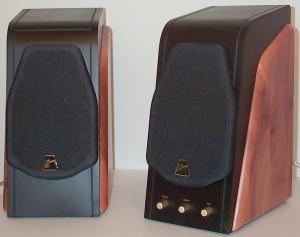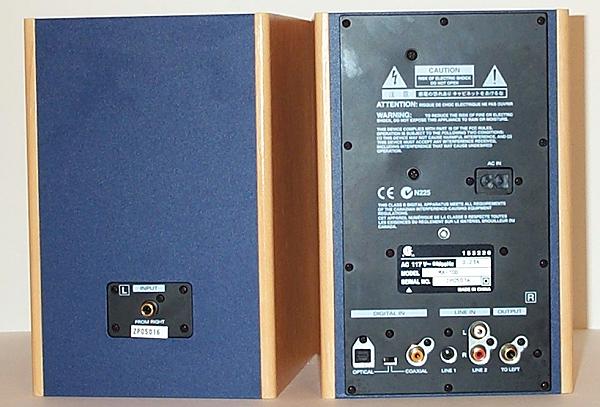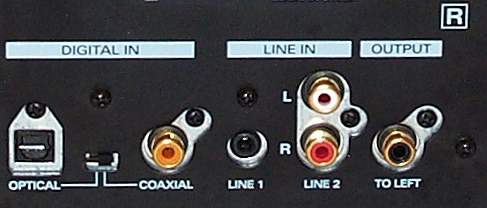|
|

Swans

Edirol
|
|
Specifications:
Swans M200 Multimedia Speakers
●
Two way, rear ported.
●
Frequency Response: 55hz to 18khz
●
Power amp rating: 36wpc
●
Dimensions: 13"H x 7"W x 10.5"D
●
Weight: 26 pounds pair
●
MSRP: $299 per pair
Swans
Website: www.theaudioinsider.com
Edirol MA-10 D Micro-Monitors
●
Two way, front-ported.
●
Power amp rating: 10 wpc
●
MSRP: $175 per pair
Edirol Corporation
North America
Website:
http://www.edirol.com/ |
|
Introduction
In an audiophile utopia, we would be able to hear any piece of music on
demand, with the highest fidelity of reproduction. But in the real world, we
slog most of our waking hours, away from our beloved music. We do this so we
can afford to pay for our gear, media, and other incidentals (e.g., house,
car, food, etc). The tragedy is that we spend most of our time earning money
and have very little time being able to enjoy it. So how about if we could
bring some of that satisfaction to our place of work? This would give us a
little extra pleasure in our lives.
So, for those of us who spend several hours a day in front of a PC at work,
it would be conceivable to add this extra sprinkle of nicety. Unfortunately, the
dinky little speakers generally available for use with PCs are a far cry
from having the ability to provide the kind of delight we crave. At best, they
can be relegated to the task of providing information in the sense that they
are fine for intelligibly understanding the sound they put out, but forget
about enjoying it like we would with our main gear.
Well, here are two products that could bridge that gap. They are powered,
compact enough, and compatible with a PC's output to serve the purpose. Let's
see if they fit the bill and can bring some fun to our stoic desktops.
The Products
Swans
are distributed in the U.S. by The Audio Insider, and sourced from the mammoth HiViResearch in China. HiViResearch has over half a million
square feet of
production space and manufacturers about 2 million speakers a year.
Swans actually produces a full line of speakers, including the previously
reviewed Diva 4.1. The product under review here is their only entry in the powered,
compact category. It is definitely aimed at the audiophile who is looking to
improve sound quality wherever they have to rely on puny built-in or stock
transducers.
The front panel of the main speaker has a volume/standBy knob and tone
controls. The rear has an AC input, power switch, pair of RCA
jack for line-in, and a heavy duty set of speaker posts. The passive unit
also has the same heavy duty speaker post to input the speaker level signal
from the main unit. The speakers are finished in a black vinyl with
wood-grained side panels, and a removable black grille. The fit and finish
on this product is beyond reproach. It is a large unit for the
desktop, but it looks quite attractive.
The speakers are a two-way rear-ported design. You will need to keep the ports
from being placed within 6” of a rear wall to avoid excessive bass
reinforcement. Also, keep the wires in the back away from the ports to avoid
interference. The line level inputs feed into a built-in amplifier that
delivers 36 wpc. That may not sound like a lot, but I never went past the 12
o'clock position, and never encountered any distortion or compression.

The Edirol MA-10D Amplified Digital Micro-Monitors are a two-way
bass-reflex design with two ports in the front.
Edirol is a division of Roland Corp., which is a well know name in
professional audio. Edirol specializes in desktop media production products. There are two 10W amps built-into
the main speaker of the MA-10Ds. One of the amps transfers an amplified signal to the
passive companion via an RCA connection on the rear. The rear of the main
speaker has a user selectable set of coax and optical digital inputs that
feed into a built-in 24/96 DAC. The rear panel also has a set of RCA line
level inputs that feed into the power amp, and a single RCA connection for a
speaker level input. Thus, these speakers can be used with a digital or line-level or speaker-level input. Now that is versatile!
The speakers come with
a blue vinyl finish and wood-grained side panels. They are quite pleasing to
look at from a distance, but from up-close, the inexpensive fit and finish of the
drivers and controls did bother me, in addition to making me wonder about
the overall quality of the product. The front panel of the passive speaker
has no controls, while the main speaker has a power switch, headphone jack, tone
controls, balance, digital input, and volume control.


Other than the basic
information above, I could not get much additional technical data. At
these price points, the manufacturer has to sell a ton of product to make a
worthwhile return, and they probably do not put in the kind of design effort
or components that are appropriate to disclose details about. They certainly do not
make that information available to the press or public, and perhaps with
good reason. These products may not have impressive designs or components,
but do an excellent job and provide awesome value. The message from
the manufacturers is that you should enjoy the product and not worry about how we made
it. That attitude is their prerogative, but I found it frustrating to not be
able to find out much about how they are built. For some of us, this
hobby is as much a journey of knowledge as it is of enjoyment, so it is a shame
when some manufacturers do not support both needs.

Setup
Both sets of speakers were auditioned
with my computer desk at home, placed on either side of my PC monitor. The
speakers were placed about 34” apart and 46” inches from my ears. The
speakers were also pulled a little ahead of the front of the monitor. All
three were set up firing straight ahead.
I am not as meticulous as other fellow hobbyists about speaker placement. I
follow basic precepts, but try not to get too caught up in
micro-measurements. But, with this review I had to be quite a bit more
accurate because of the close distances. A 1" disparity that may not
be noticed 8' away, is quite significant when it is less than 4' away.
With the rear ports on the Swans, you will need to be mindful of the distance
from the rear wall. If you have to place them less than 6” from the rear
wall, you can get bass loading, giving you a
tremendous amount of LFE which will adversely affect the balance and could
interfere with the signals traveling through the line and speaker level
wires in the rear. However, this is better than stuffing the ports, which
would change the tuning. When I had the walls at a distance of 8” from the rear, I had no issues.
The speakers were connected to the line-out on my SoundBlaster Live card
with the stock ¼” to RCA interconnect. I did experiment with trying to
connect the Edirol to the digital out on the SoundBlaster, but could not
find a digital interconnect rated at 75 Ohms with a SPDIF/RCA complement of
jacks. I had to resort to using a RadioShack ¼” to RCA adaptor, but that
really defeats the purpose. The built in DAC in the Edirol would
theoretically benefit from being fed a digital signal, compared to a line
level signal from a PC soundcard into the RCA jacks. But with a questionable
connection it would be unfair to try and do a comparison. SoundBlaster cards
used to have a very bad problem in that they unilaterally applied sample
rate conversion to 48 kHz and then applied a bunch of unnecessary DSP that
you couldn't turn off, in which case the analog input/outputs were actually
better. But, the cable issue isn't really important if the cable runs are
under two meters, where impedance reflections at frequencies for standard
two-channel digital audio are negligible. It's technically ideal to have a
75 ohm cable, but not absolutely necessary if the distance is short.
The Sound
For my listening tests, I
compared the two speakers to a Harman/Kardon HK195 speaker set that came with my Dell
PC. I fully expected the HK to not measure up to the other two, but wanted
to give you some reference of what these two units would sound like in
comparison to a ‘stock' PC speaker.
There were no surprises here at all. The Swans finished
ahead of the pack by a great measure. The Edirols came in
second, and the HK195 a distant third. I ran tests with all three speakers
calibrated at 60 dB and 80 dB with pink noise (recorded at –20 dB) at the
listening position. Here is what I heard.
At the 60 dB level, a 65 Hz tone was barely noticeable on the HK195, and at the
80 dB level, while it was a little louder, I would not regard it of usable
loudness. I would estimate the HK195 was usable down to about 75 Hz. The Edirol was beyond the limits of usable at 40
Hz with the 80 dB setting, and
50 Hz with the 60 dB setting. At the same settings, the Swans put out quite a
bit of clean bass, and I would estimate the usable limits to be at about
35 Hz at the 80 dB setting, and 45 Hz at the 60 dB setting. It made a huge
difference to have a near full-range speaker hooked-up to my PC. That made
all the difference in the world in terms of total involvement.
Playing
‘All or Nothing at All' (Diana Krall, Love Scenes, Impulse, IMPD233), the
HK195 barely allowed the instruments to be recognized, the double-bass and
guitar could not be heard at all at the 60 dB setting. When I tried to turn
up the volume to the 80 dB setting, there was an unbearable amount of
distortion, never mind trying to listen to instruments.
The Edirols also distorted at the 80 dB setting, though not to the same
extent as the HK195. At the 60 dB setting, I could barely hear the double-bass
and the guitar, and I only heard them because I was straining to hear them.
The only speakers that gave me
any joy on this recording were the Swans. The double-bass was properly
weighted at both the 60 dB and the 80 dB setting, with no hint of distortion
or compression. The vocals were not quite as rich or detailed as what I have
heard on my other systems, but you must realize I am comparing $300 worth of
speakers and amplification with setups costing 5 to 20 times as much. With
that caveat aside, I must say that I have never had so much enjoyment at a
desk. It may not have had all the detail I am used
to, but it had enough to be regarded as high-fidelity. Remember, nearfield
listening does increase the apparent detail and bass response.
With
‘Summertime' (Lesly Olsher, Stereophile Test CD1, STPH002-2), basically,
there was a significant improvement in dynamics and tonality as I moved from
the HK195 to the Edirols and to the Swans. Unfortunately, none of them could
render the sense of space (it was recorded in a basement) that I know lies
in that recording. I almost wanted to do the same test with my SACD or DVD
player as the source instead of the PC, but that would be moot for the
purposes of this review. I only want to report what you can expect to hear
on your desktop.
Using
‘Zapateado' (Pepe Romero, Flamenco, Phillips, 422069-2), the HK195
completely butchered the track. The dancer's footwork sounded miniscule,
and the guitar sounded enormous (which is the complete opposite of what it
is). There also was a complete lack of the great soundstage this recording
has. The Edirol put a smile back on my face, and some of the soundstage returned
though not as deep or wide as it should be, but the guitar and dancer were
put in their proper perspectives. With the Swans I was really able to hear
most of the magic in this recording. The soundstage was both deep and wide,
and I could also start to feel some of the physical impact of the footwork.
‘So What' (Miles Davis, Kind of Blue, Columbia, B000002ADT) – Again the HK
disappointed and only served as a benchmark. The double-bass was nowhere to
be heard, the trumpet sounded shrill, and there was no soundstage to speak
of. The Edirols made the trumpet sound tolerable, but the soundstage still
was non-existent, and the double bass could barely be heard only if I
strained to pick it out. Again, the Divas came out at the top and brought
the double-bass to life. The soundstage did appear, but again not to the extent that I am
used to, and the trumpets did actually sound enjoyable.
‘O Grande Amor' (Stan Getz and Joao Gilberto, Getz/Gilberto, Verve
314521414-2) – With the HK there was a complete absence of low frequencies,
and this made the wire brush sound more prominent. This could be mistaken
for high frequency detail, but it isn't, because it simply is high frequencies in
the absence of lower ones. There also was a slight chestiness to the male
vocals, which is most likely due to a hump in whatever bass the speakers put
out in an attempt to make them sound adequate. The Edirols did quite well on
this track, especially in terms of tonality of the drumsticks hitting the
rim or the wire brush on the cymbals, and I would say this was the only test in
which they bettered the Swans. They also did not display any chestiness on
male vocals, which is surprising since I would have expected the designers
to exaggerate the upper/mid-bass response to make the speakers sound like
they had more body. I commend the Edirol team on not giving in to that
temptation. The Swans again came out ahead
overall, even though the tonality of the drumsticks and wirebrush was not
quite what I know it to be, or what the Edirol's delivered. The Swans did
present a nice soundstage, and placed the drum kit just outside of the left
speaker. The real magic was in the delivery of the richness in Stan Getz's
tenor sax solo. Chestiness on male vocals could be an issue if the speakers
were too close to the rear wall.
Conclusions
If you crave listening to music at your desk, and
want it with some semblance of high fidelity, get the Swans. They will not
compare to a $3,000 system, but that is not their purpose. Sitting next to
your computer though, they will surprise and please you.
The Edirols are not a bad second choice, but they lack the bass, power handling,
and finesse of the Swans. The Edirols did have slightly better tonality on some
high frequency passages. I could not get over the sloppy construction, but
in the end, the sound is most important. The built in DAC could
really be handy in some situations.
As to the HK, you really should not pay more than $20 for these. They are
sufficient for conveying ‘audio information', but do not expect any form of
enjoyment in terms of high-fidelity.
- Arvind
Kohli -
Terms and Conditions of Use

|









